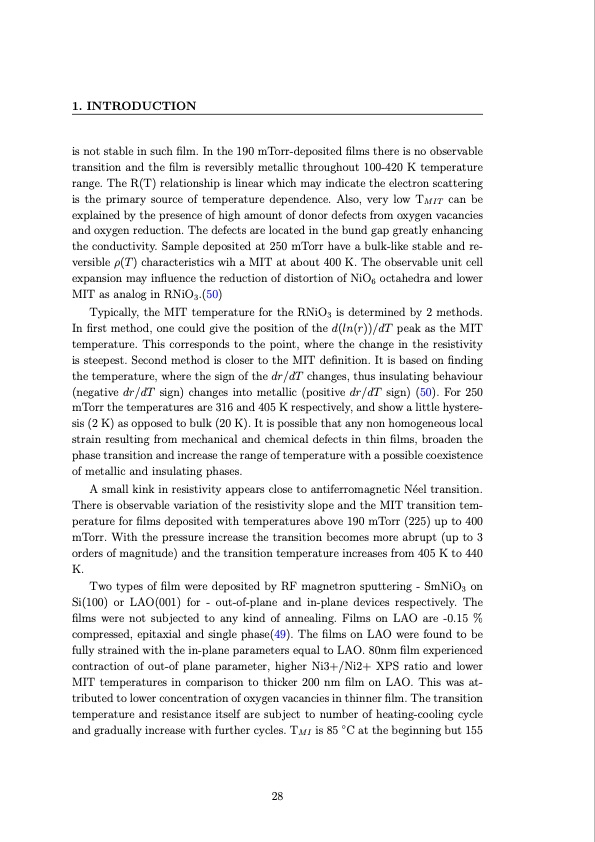
PDF Publication Title:
Text from PDF Page: 049
1. INTRODUCTION is not stable in such film. In the 190 mTorr-deposited films there is no observable transition and the film is reversibly metallic throughout 100-420 K temperature range. The R(T) relationship is linear which may indicate the electron scattering is the primary source of temperature dependence. Also, very low TMIT can be explained by the presence of high amount of donor defects from oxygen vacancies and oxygen reduction. The defects are located in the bund gap greatly enhancing the conductivity. Sample deposited at 250 mTorr have a bulk-like stable and re- versible ρ(T) characteristics wih a MIT at about 400 K. The observable unit cell expansion may influence the reduction of distortion of NiO6 octahedra and lower MIT as analog in RNiO3.(50) Typically, the MIT temperature for the RNiO3 is determined by 2 methods. In first method, one could give the position of the d(ln(r))/dT peak as the MIT temperature. This corresponds to the point, where the change in the resistivity is steepest. Second method is closer to the MIT definition. It is based on finding the temperature, where the sign of the dr/dT changes, thus insulating behaviour (negative dr/dT sign) changes into metallic (positive dr/dT sign) (50). For 250 mTorr the temperatures are 316 and 405 K respectively, and show a little hystere- sis (2 K) as opposed to bulk (20 K). It is possible that any non homogeneous local strain resulting from mechanical and chemical defects in thin films, broaden the phase transition and increase the range of temperature with a possible coexistence of metallic and insulating phases. A small kink in resistivity appears close to antiferromagnetic N ́eel transition. There is observable variation of the resistivity slope and the MIT transition tem- perature for films deposited with temperatures above 190 mTorr (225) up to 400 mTorr. With the pressure increase the transition becomes more abrupt (up to 3 orders of magnitude) and the transition temperature increases from 405 K to 440 K. Two types of film were deposited by RF magnetron sputtering - SmNiO3 on Si(100) or LAO(001) for - out-of-plane and in-plane devices respectively. The films were not subjected to any kind of annealing. Films on LAO are -0.15 % compressed, epitaxial and single phase(49). The films on LAO were found to be fully strained with the in-plane parameters equal to LAO. 80nm film experienced contraction of out-of plane parameter, higher Ni3+/Ni2+ XPS ratio and lower MIT temperatures in comparison to thicker 200 nm film on LAO. This was at- tributed to lower concentration of oxygen vacancies in thinner film. The transition temperature and resistance itself are subject to number of heating-cooling cycle and gradually increase with further cycles. TMI is 85 ◦C at the beginning but 155 28PDF Image | Investigation of metal-insulator transition in magnetron sputtered samarium nickelate thin films

PDF Search Title:
Investigation of metal-insulator transition in magnetron sputtered samarium nickelate thin filmsOriginal File Name Searched:
Bilewska_Investigation_of_metal_insulator_transition_in_magnetron_sputtered_samarium.pdfDIY PDF Search: Google It | Yahoo | Bing
Sulfur Deposition on Carbon Nanofibers using Supercritical CO2 Sulfur Deposition on Carbon Nanofibers using Supercritical CO2. Gamma sulfur also known as mother of pearl sulfur and nacreous sulfur... More Info
CO2 Organic Rankine Cycle Experimenter Platform The supercritical CO2 phase change system is both a heat pump and organic rankine cycle which can be used for those purposes and as a supercritical extractor for advanced subcritical and supercritical extraction technology. Uses include producing nanoparticles, precious metal CO2 extraction, lithium battery recycling, and other applications... More Info
| CONTACT TEL: 608-238-6001 Email: greg@infinityturbine.com | RSS | AMP |